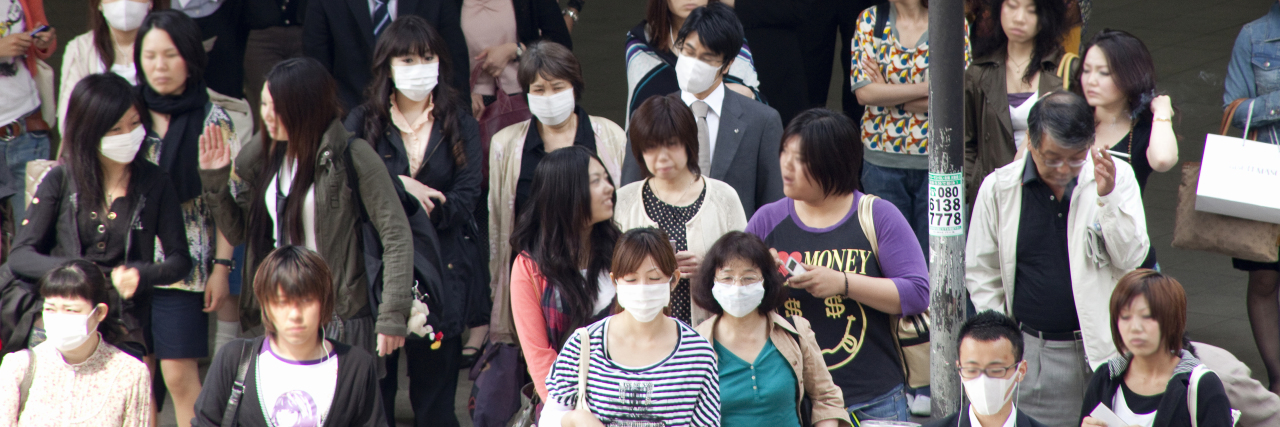What It's Like to Be Chronically Ill During Japan’s Coronavirus Outbreak
The numbers are shifting from minute to minute, but it now appears fairly certain that the new coronavirus has sparked a true international pandemic. By now, most people have heard so much about COVID-19 that even the most optimistic among us are starting to worry. “Should I stock up on toilet paper and water?” “Will my local district follow international trends and close schools? If so, how will I work and keep up with my bills?”
But as someone with multiple autoimmune illnesses, my worries take a different shape. It’s not just that the new virus is, as every news story likes to reassure the healthy public, most deadly for those with underlying illnesses, and most especially those with my very own diabetes. (Although that is, indeed, very troublesome.) And it’s not just that my diabetes leaves me immunocompromised, or that my asthma and myasthenia gravis leave me at risk for pneumonia and temporary paralysis of my diaphragm and throat muscles. (But yes, yikes.)
Instead, my worry is something much more palpable, a seething desperation that has welled up in my chest as I have realized with horror that I am going to be unable to avoid dragging my especially vulnerable body straight to a slew of university hospitals in the middle of this outbreak. Not because I am ill and in need of hospital care or testing, but because I simply cannot get refills for my many mission-critical prescription medications without showing up, in person, to my regular follow-up appointments.
You see, I have settled down to live with my family in Japan, and that is where I find myself, and all of my doctors and medications, as I sit here typing today. Under normal circumstances, I am reassured that the Japanese health care system is quite accessible for disabled and chronically ill people, regardless of income or ability to pay. But today, looking at Japanese hospitals with the fresh eyes of someone with multiple chronic illnesses, I see nothing but a disaster waiting to happen.
In Japan, patients with illnesses like mine are generally managed through the outpatient services of major research hospitals. I currently see five specialists at three different hospitals. And there is no refill system here, so every time I need a refill, I have to visit my doctors in person.
This would be bad enough in the United States, but in Japan, it’s disastrous. Japanese hospitals have open-plan designs, with waiting rooms that flow from one department into the next and are located in the hallways. In order to get to my endocrinologist for an insulin and pump supply refill, I have to check in on a touchscreen machine that is used by all scheduled patients. After that, I proceed to a large waiting room to have my blood drawn in a booth sitting between two other patients. And then, I need to walk through and sit near the waiting area for infectious diseases and pulmonology. Great. (Having asthma and chronic sinusitis means I need to visit my pulmonologist directly as well.) The wait times are one to two hours as a matter of course, because I am waiting for blood test results and the appointments are scheduled for unrealistically short slots of as few as three minutes.
Even after my appointment is finally over, I am still not free to leave. I have to take my file to the lobby waiting area, which is teeming with people who have just wrapped up their own visits, and wait for my bill to be calculated so I can pay. Only then am I free to go home, often three to four hours after arriving at the hospital.
This system of mandatory visits for each refill is a shamefully disastrous design from an infection control perspective. Autoimmune patients are literally showing up at major hospitals for routine refills of steroids and even more potent immunosuppressant medications. On the balance, maybe it’s nice to have a chat with the doctor every so often, but we are not in that balanced, everyday scenario. We are in a pandemic.
Although Japan is pushing parents to keep their children at home and workers to stay out of the office, nobody is breathing a word about the most COVID-vulnerable of all, the chronic illness patients. For us, Japan’s “business-as-usual” approach prevails.
Being overlooked is nothing new in the land of invisible illness, but it feels especially like a betrayal at this time when the far less vulnerable are in full-blown panic mode about their own fates. While they hunker down at home with popcorn and family movie nights, I’ll be desperately phoning around to find a random non-infectious disease clinic, like an orthopedist or a dermatologist, that won’t mind going against the grain to dash off a few prescriptions for a hopelessly medically complicated patient they’ve never met. And so the world turns and the sun sets, both for the sick and the well.
This story originally appeared on Myasthenic Diabetic.
Getty image by Gyro.

